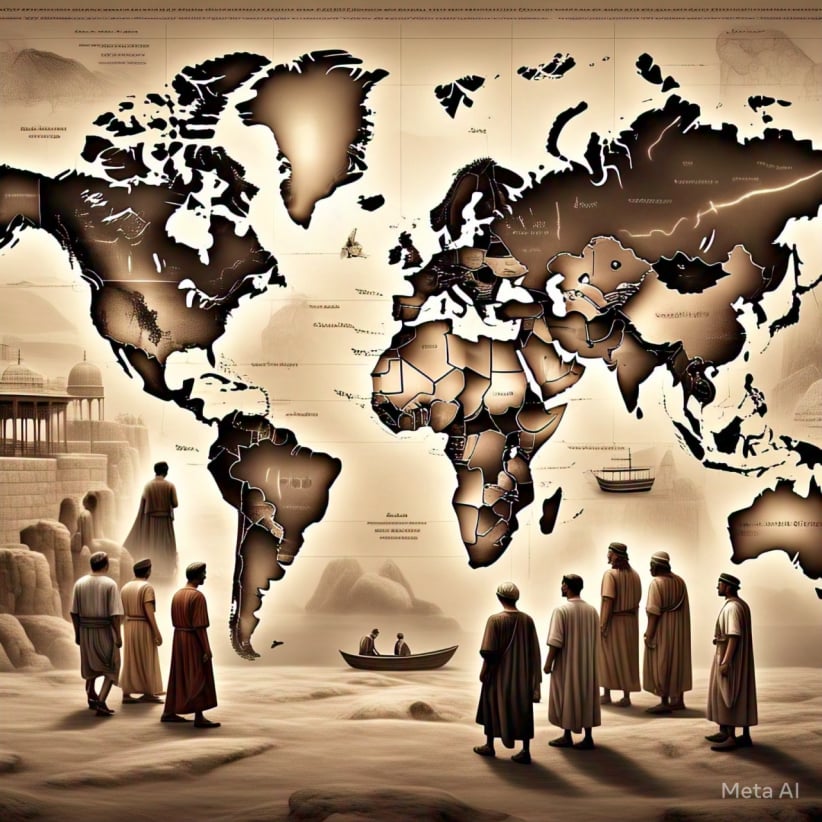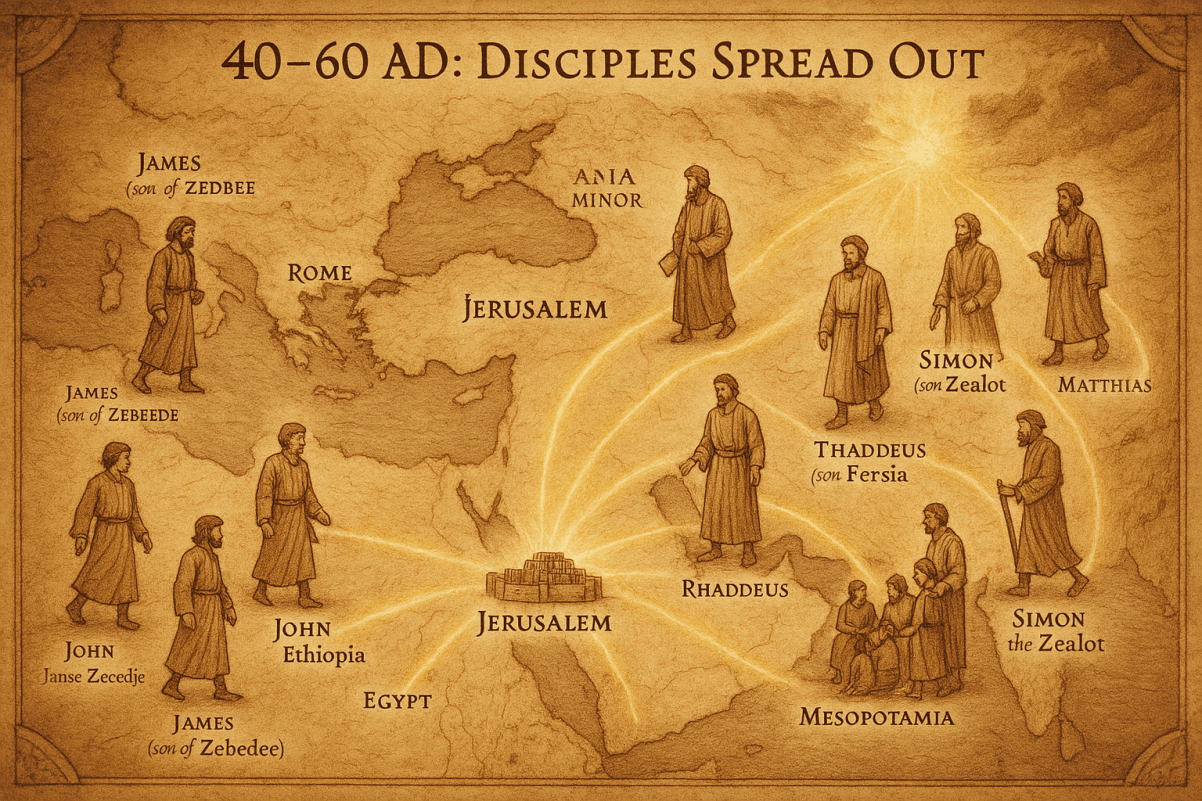

WORK
📜 **Why Did They Leave Jerusalem? (Around 36–37 AD)**
**These 3 Bibles Always Line Up — That’s Why We Use Them:**
Paleo-Hebrew Bible (\~1400–586 BC)
Aramaic Scriptures (\~600–500 BC)
Early Square Script – No Vowels (\~400–200 BC)
The disciples of Yeshua (Jesus) did **not** leave Jerusalem to start a new religion. They left because they were **scattered**, **sent**, and in many cases **forced out** — but it was all part of Yhwh’s purpose to **preserve the truth** and **call His people back**.
---
🔥 **1. Persecution Was Rising**
By 36–37 AD, the temple leaders and Roman rulers had begun targeting the followers of Yeshua. These leaders feared losing control. Just like the prophets of old, the disciples were pushed out not for rebellion, but because they carried Yhwh’s truth. Jerusalem had rejected the covenant again, and judgment was near.
📖 *Jeremiah 7:3–4*
“Thus saith Yhwh… Amend your ways and your doings… Trust not in lying words, saying, The temple of Yhwh…”
---
🕊️ **2. The Ruach Was Leading Them**
Yhwh’s Spirit (Ruach) — not a Greek “third person,” but **Yhwh’s breath and power** — moved among the faithful. Those who followed Yeshua didn’t invent a religion. They carried the same message the prophets gave: **Return to Yhwh, keep His commands, and be healed.** They were sent to Yahudim and also to the God-fearing strangers who already walked with Israel.
📖 *Isaiah 44:3*
“I will pour water upon him that is thirsty, and floods upon the dry ground: I will pour My Spirit upon thy seed…”
---
🌍 **3. The Time Was Right**
There were Yahudim living in Egypt, Parthia, Babylon, Syria, and even India. These were not “lost sheep,” but **scattered covenant people** who still remembered the name of Yhwh. The disciples didn’t need to create churches — they went out to **restore Yhwh’s covenant** where it had been forgotten. They carried the Hebrew message to a Hebrew people in exile.
📖 *Ezekiel 34:12*
“As a shepherd seeks out his flock in the day that he is among his sheep that are scattered; so will I seek out My sheep…”
---
✡️ **4. To Preserve the Hebrew Truth**
Greek ideas were already creeping in. Temple leadership was already corrupted. Rome was waiting to twist the message. The true disciples left Jerusalem not to expand religion but to **guard what was given** — Yhwh’s covenant, Yhwh’s Name, and the truth Yeshua walked in. They carried **no new testament** — only the **same Torah and Prophets** Yeshua taught from.
📖 *Amos 8:11*
“Behold, the days come, saith Yhwh, that I will send a famine… of hearing the words of Yhwh.”
---
🛑 **They Did Not Preach Paul’s Gospel**
No “grace alone.”
No “lost sheep first.”
No “Gentile gospel.”
No new religion.
The disciples of Yeshua (Jesus)
They preached what Yhwh always said:
> 🕎 **“Repent and obey — and I will redeem you. Jew or Gentile.”**
📖 *Isaiah 43:11*
“I, even I, am Yhwh; and beside Me there is no savior.”


WORK
📖 Why Did They Leave Jerusalem? (Around 36–37 AD)
The disciples didn’t leave Jerusalem because they were trying to start a new religion. They left because they were sent, scattered, and in some cases forced out—but all of it fulfilled prophecy and divine purpose.
🔥 1. Persecution Was Rising
By 36–37 AD, the followers of Yeshua faced growing persecution from religious leaders and Roman authorities. Stephen had just been stoned (Acts 7), and many believers were being hunted. This drove many out of Jerusalem—not in fear, but in faithful obedience to YHWH’s call to spread the message.
🕊️ 2. The Spirit Was Leading Them
This was not a random scattering. The Ruach (Spirit of God) was guiding them to go to Judea, Samaria, and to the ends of the earth—just as Yeshua had commanded. The message of the Kingdom was never meant to stay in one place. It had to reach the lost sheep of Israel and the God-fearing Gentiles across the nations.
🌍 3. The Time Was Right for Global Expansion
The Roman roads, Jewish synagogues spread across the empire, and the unrest in Judea all made this the perfect time for the gospel to go global. The disciples were walking into prophecy, bringing the light of truth to places like Syria, Armenia, Egypt, India, and more—long before Paul ever began traveling.
✡️ 4. To Preserve the Hebrew Truth
Before Greek influence took over, before church councils rewrote the faith, these original disciples left Jerusalem to preserve and share the true Hebrew-Aramaic message of Yeshua. They carried it firsthand—unaltered, unfiltered, and full of the authority that only eye-witnesses could bring.
Summary of 40–60 AD:
The original disciples of Yeshua spread out from Jerusalem to every corner of the known world.
Their message remained Hebrew, Torah-rooted, and focused on the Kingdom.
They spoke in Hebrew and Aramaic, not Greek.
They built communities, not empires.
Their writings and teachings were later suppressed or replaced by the Roman Church’s version of Christianity.